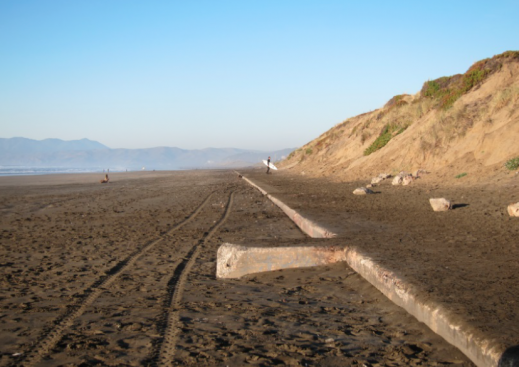SPUR, working with the San Francisco Public Utilities Commission and a top-notch team of coastal and structural engineers, has completed a significant engineering study that validates the Ocean Beach Master Plan approach to coastal management. The plan's approach combines managed retreat, beach nourishment, and low-profile protection structures. At issue is severe coastal erosion that threatens the Lake Merced Tunnel, a key piece of the SFPUC's wastewater infrastructure. Portions of the tunnel are protected by emergency revetments (boulder embankments) but these are at odds with the Coastal Act and must eventually be removed. Key findings of the report include:
Coastal protection structures can and should address many objectives
This report stipulates that coastal protection measures at Ocean Beach should be designed to support coastal access, ecological and habitat functions, and aesthetics, in addition to protecting threatened infrastructure.
Coastal storms threaten a few locations now, more over time
A close analysis of coastal hazards break the area south of Sloat Boulevard into distinct "reaches" (sections of coastline) and looks at the exposure of each to coastal erosion, both today and over time as sea level rise sets in. It considers the distance between the bluff face and the Lake Merced Tunnel and also the presence of exposed rubble, boulder revetments, and native geology for a much more precise picture of the existing hazards.
A low-profile structure can installed from above, close to the Lake Merced Tunnel
Engineers created structural model of the Lake Merced Tunnel to figure out how much of a buffer it requires above and to the side to be safe. The goal was for protective structures to go as close to the tunnel as safely possible, to minimize disruption of coastal processes and access. The results support a structure that is installed from above, and would be invisible until exposed by erosion. Even then, it would be covered by sand much of the time, similar to the nearby Taraval seawall.
 The Taraval seawall, just north of Sloat Boulevard, is a useful precedent for low-profile protection structures at Ocean Beach. Often invisible under the sand, it provides coastal protection with minimal impacts to coastal processes and beach access. Photo by Elena Vendebroek.
The Taraval seawall, just north of Sloat Boulevard, is a useful precedent for low-profile protection structures at Ocean Beach. Often invisible under the sand, it provides coastal protection with minimal impacts to coastal processes and beach access. Photo by Elena Vendebroek.
A phased approach could address key locations first, and proceed adaptively
Coastal protections are expensive and require complex capital planning, environmental review, and regulatory permitting. At the same time, major investments in a changing landscape are best made in phases, an "adaptive management" approach that allows coastal managers to learn from each step and intervene only as required. These factors (long lead times and nimble adaptation) are in tension and inform how the proposed measures would be phased. All at once? A small pilot? Somewhere in between? Two important criteria that will inform the phasing are 1) areas where the erosion hazard is acute and 2) areas where emergency revetments need to be removed to comply with the Coastal Act.
Existing boulder revetments can be removed
Once protective measures are in place, the emergency revetments at Ocean beach can be removed once and for all, improving habitat, beach access, and compliance with coastal regulations. The City has made clear its intention to do just that, and is working closely with the Coastal Commission to move this program forward.
Project Team:
ESA PWA - coastal process and hazard analysis
Moffatt and Nichol - coastal engineering
McMillen Jacobs and Associates - structural engineering
AGS, Inc - geotechnical engineering
